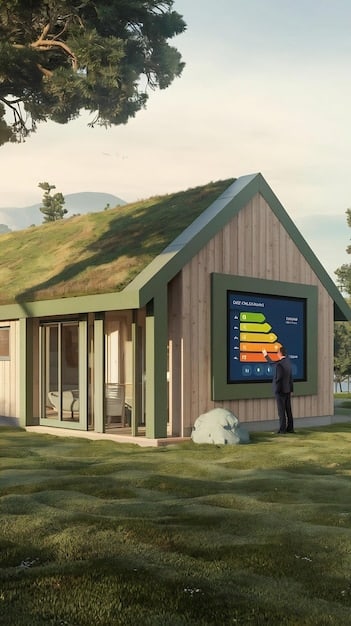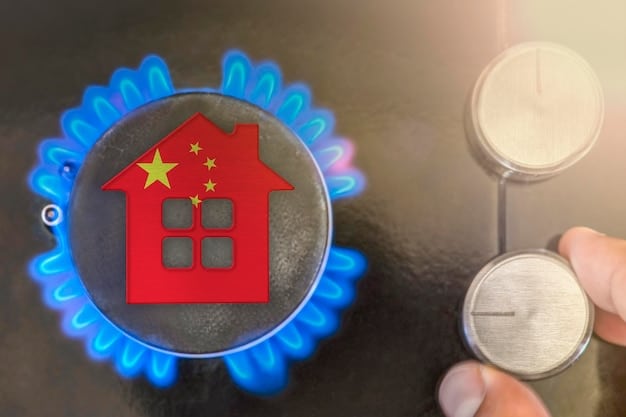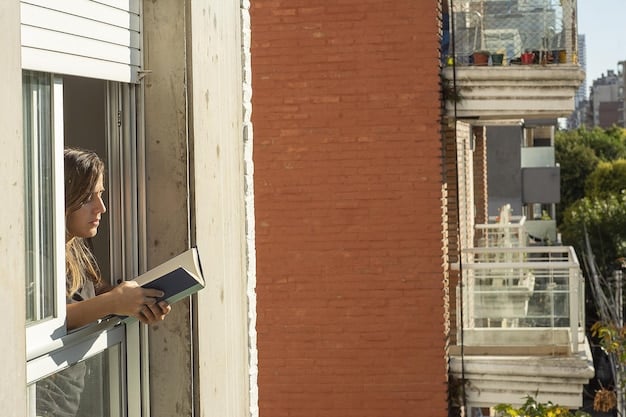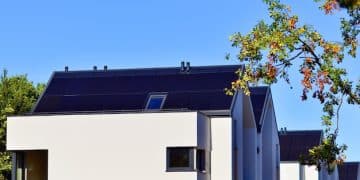Maximize Savings: New Tax Credits for Energy-Efficient Home Improvements

New tax credits for energy-efficient home improvements offer homeowners in the U.S. significant financial incentives to upgrade their homes, reducing energy consumption and lowering utility bills if they act before the credits expire.
Did you know that upgrading your home with energy-efficient improvements could not only reduce your carbon footprint but also put money back in your pocket? The **new tax credits for energy-efficient home improvements: act before they expire** are designed to help homeowners invest in a more sustainable future while enjoying substantial savings. Let’s explore how you can take advantage of these opportunities.
Understanding the Energy Efficiency Tax Credits
The U.S. government offers various tax credits to encourage energy efficiency. These incentives aim to reduce the nation’s energy consumption and promote the use of renewable energy sources. Understanding these credits is the first step towards making informed decisions about your home improvements.
These tax credits are available for a range of upgrades, from installing energy-efficient windows and doors to upgrading your HVAC system. Let’s delve into the details of what these credits entail and how you can qualify.
What are Energy Efficiency Tax Credits?
Energy efficiency tax credits are financial incentives offered by the government to homeowners who invest in energy-efficient upgrades. These credits can significantly offset the cost of improvements, making it more affordable to create a greener home.
Why are These Tax Credits Important?
These credits are important for several reasons. They encourage homeowners to reduce their energy consumption, lower their utility bills, and decrease their environmental impact. Additionally, they stimulate the economy by promoting the growth of the energy-efficient products market.

- Reduced Energy Consumption: Energy-efficient upgrades help lower the amount of energy your home consumes.
- Lower Utility Bills: By using less energy, you can significantly reduce your monthly utility expenses.
- Environmental Impact: Energy efficiency contributes to a smaller carbon footprint and a healthier planet.
- Economic Benefits: These credits incentivize investment in sustainable products and technologies.
Understanding the value of these tax credits empowers homeowners to make informed decisions about upgrading their homes. By taking advantage of these incentives, you can create a more comfortable, sustainable, and cost-effective living environment.
Key Tax Credits Available for Homeowners
Several key tax credits are available for homeowners looking to make energy-efficient upgrades. Two significant ones are the Energy Efficiency Home Improvement Credit and the Residential Clean Energy Credit. Knowing the specifics of each can help you maximize your savings.
These credits cover a wide array of improvements, from upgrading insulation to installing solar panels. Let’s take a closer look at each credit to see what they offer and how you can benefit.
Energy Efficiency Home Improvement Credit (25C)
The Energy Efficiency Home Improvement Credit, also known as Section 25C, provides a credit for qualified energy efficiency improvements to your home. This includes upgrades like energy-efficient doors, windows, insulation, and HVAC systems.
Residential Clean Energy Credit (25D)
The Residential Clean Energy Credit, or Section 25D, is designed for renewable energy systems like solar, wind, and geothermal. This credit can cover a significant portion of the cost of installing these systems in your home.
- Energy Efficiency Home Improvement Credit (25C): Covers upgrades like insulation, energy-efficient doors and windows, and efficient HVAC systems.
- Residential Clean Energy Credit (25D): Focuses on renewable energy systems such as solar panels, wind turbines, and geothermal heat pumps.
- Credit Amounts: The 25C credit can cover up to a certain percentage of the project cost, while 25D can cover a higher percentage.
- Eligibility: To be eligible, improvements must meet specific energy efficiency standards and be installed in your primary residence.
By understanding the differences and benefits of each credit, homeowners can strategically plan their upgrades to maximize their tax savings. These incentives make it more feasible to invest in a sustainable and energy-efficient home.
Eligible Home Improvements and Products
To take advantage of the tax credits, it’s crucial to know which home improvements and products qualify. The eligible upgrades often include insulation, energy-efficient windows and doors, HVAC systems, and renewable energy systems.
Each category has specific requirements and standards that must be met to qualify for the tax credits. Let’s explore some of the key improvements and products in more detail.
Insulation
Proper insulation is crucial for maintaining a comfortable temperature and reducing energy loss. The tax credits often cover the cost of upgrading insulation in attics, walls, and basements.
Energy-Efficient Windows and Doors
Upgrading to energy-efficient windows and doors can significantly reduce drafts and heat loss. To qualify for the tax credit, these products must meet Energy Star standards.

Investing in eligible home improvements not only qualifies you for tax credits but also enhances the overall efficiency and comfort of your home. By understanding the criteria for each type of upgrade, you can make informed decisions that benefit both your wallet and the environment.
How to Claim Your Energy Efficiency Tax Credits
Claiming your energy efficiency tax credits involves a few key steps. These include gathering documentation, filling out the correct tax forms, and understanding the credit limitations. By following these steps carefully, you can ensure you receive the full benefits of the credits.
Knowing the process for claiming these credits will help you avoid common mistakes and ensure a smooth experience. Let’s break down the process into manageable steps.
Gathering Documentation
Start by gathering all relevant documentation, including receipts for materials and labor, product specifications, and any certification documents. These documents will serve as proof of your eligible expenses.
Filling Out the Correct Tax Forms
You will need to fill out specific tax forms to claim the credits. Depending on the type of credit, you may need Form 5695 for energy efficiency improvements or other relevant forms for renewable energy systems.
- Gather all receipts: Keep records of all expenses, including materials and labor.
- Use Form 5695: This form is used to claim most energy efficiency tax credits.
- Check credit limitations: Be aware of the maximum credit amounts and any limitations.
- Consult a tax professional: If needed, seek assistance from a tax professional to ensure accuracy.
By meticulously following these steps, you can successfully claim your energy efficiency tax credits and enjoy the financial benefits of your sustainable home improvements. Proper preparation and attention to detail are essential for a seamless process.
Maximizing Your Tax Credit Savings
To maximize your tax credit savings, it’s important to plan your upgrades strategically, take advantage of all available incentives, and stay informed about any changes to the tax laws. Little details can make a significant difference in the amount of savings you receive.
Effective planning and awareness will help you make the most of these opportunities. Let’s explore some tips for maximizing your tax credit savings.
Plan Your Upgrades Strategically
Prioritize upgrades that offer the highest energy savings and the greatest tax credit eligibility. Consider getting a professional energy audit to identify the most impactful improvements for your home.
Take Advantage of All Available Incentives
In addition to federal tax credits, look for state and local incentives, rebates, and grants. Combining these incentives can significantly reduce the overall cost of your energy-efficient upgrades.
By implementing these strategies, homeowners can significantly boost their tax credit savings and make their investments in energy efficiency even more worthwhile. Taking a proactive and informed approach is key to maximizing the financial benefits.
The Future of Energy Efficiency Tax Credits
The future of energy efficiency tax credits looks promising as governments continue to prioritize sustainability and energy conservation. Staying informed about potential extensions, changes, or new incentives will help you make the most of these opportunities.
The ongoing evolution of energy efficiency tax credits reflects the growing importance of sustainable living. Let’s consider the potential future developments in this area.
Potential Extensions and Changes
Keep an eye on potential extensions or changes to the existing tax credits. Governments often adjust these incentives to better align with current energy goals and technological advancements.
New Incentives and Programs
Be aware of new incentives and programs that may emerge in the future. These could include credits for specific types of energy-efficient technologies or programs that provide additional support for low-income households.
- Stay informed: Regularly check for updates on tax credits and incentives.
- Plan for the future: Consider how potential changes may impact your upgrade plans.
- Advocate for sustainability: Support policies that promote energy efficiency and renewable energy.
- Seek professional advice: Consult with experts to navigate the evolving landscape of tax credits.
Remaining vigilant and proactive will ensure that you can continue to take advantage of the benefits offered by energy efficiency tax credits. These incentives will likely play an increasingly important role in promoting sustainable home improvements in the years to come.
| Key Point | Brief Description |
|---|---|
| 💡 Energy Efficiency Credit | For upgrades like insulation, windows, doors, and HVAC. |
| ☀️ Clean Energy Credit | Covers solar, wind, and geothermal systems. |
| 📝 Claiming Credits | Gather documents, fill Form 5695, and be aware of limits. |
| 💰 Maximize Savings | Strategize upgrades, use all incentives, and stay informed. |
Frequently Asked Questions
▼
The Energy Efficiency Home Improvement Credit, known as Section 25C, provides tax credits to homeowners who make qualified energy-efficient upgrades to their homes, such as insulation, energy-efficient windows, and HVAC systems.
▼
The Residential Clean Energy Credit, or Section 25D, covers renewable energy systems like solar panels, wind turbines, and geothermal heat pumps installed in your primary residence, helping to offset installation costs.
▼
To gather necessary documents, keep all receipts for materials and labor, product specifications, and any certification documents related to your energy-efficient upgrades. These documents serve as proof of eligible expenses.
▼
To claim energy efficiency tax credits, you’ll typically need to fill out Form 5695. This form is specifically designed for claiming credits related to energy-efficient home improvements and renewable energy systems.
▼
To maximize savings, strategically plan your upgrades, take advantage of all available incentives (federal, state, and local), stay informed about changes in tax laws, and consult with tax professionals when needed.
Conclusion
In conclusion, taking advantage of the **new tax credits for energy-efficient home improvements: act before they expire** offers a fantastic opportunity to save money while making your home more sustainable. By understanding the available credits, eligible improvements, and claiming process, homeowners can create a comfortable and eco-friendly living space.





